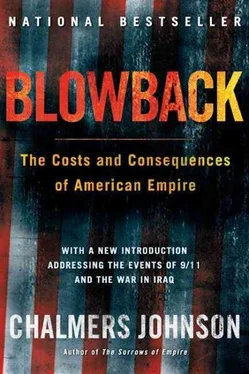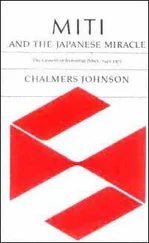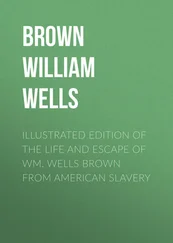Chalmers Johnson - Blowback, Second Edition - The Costs and Consequences of American Empire
Здесь есть возможность читать онлайн «Chalmers Johnson - Blowback, Second Edition - The Costs and Consequences of American Empire» весь текст электронной книги совершенно бесплатно (целиком полную версию без сокращений). В некоторых случаях можно слушать аудио, скачать через торрент в формате fb2 и присутствует краткое содержание. Год выпуска: 0101, ISBN: 0101, Издательство: Macmillan, Жанр: Старинная литература, на английском языке. Описание произведения, (предисловие) а так же отзывы посетителей доступны на портале библиотеки ЛибКат.
- Название:Blowback, Second Edition: The Costs and Consequences of American Empire
- Автор:
- Издательство:Macmillan
- Жанр:
- Год:0101
- ISBN:9780805075595
- Рейтинг книги:5 / 5. Голосов: 1
-
Избранное:Добавить в избранное
- Отзывы:
-
Ваша оценка:
- 100
- 1
- 2
- 3
- 4
- 5
Blowback, Second Edition: The Costs and Consequences of American Empire: краткое содержание, описание и аннотация
Предлагаем к чтению аннотацию, описание, краткое содержание или предисловие (зависит от того, что написал сам автор книги «Blowback, Second Edition: The Costs and Consequences of American Empire»). Если вы не нашли необходимую информацию о книге — напишите в комментариях, мы постараемся отыскать её.
Blowback, Second Edition: The Costs and Consequences of American Empire — читать онлайн бесплатно полную книгу (весь текст) целиком
Ниже представлен текст книги, разбитый по страницам. Система сохранения места последней прочитанной страницы, позволяет с удобством читать онлайн бесплатно книгу «Blowback, Second Edition: The Costs and Consequences of American Empire», без необходимости каждый раз заново искать на чём Вы остановились. Поставьте закладку, и сможете в любой момент перейти на страницу, на которой закончили чтение.
Интервал:
Закладка:
General Park’s associate in the 1961 coup was General Kim Jong-pil, who proceeded with the help of the U.S. Central Intelligence Agency to create the Korean Central Intelligence Agency in order to consolidate Park’s military rule. The KCIA was and is a secret-police apparatus accountable only to the president of South Korea and has been used over the years to silence any and all calls for a genuine democracy. As the historian Perry Anderson observes, “In the mid-sixties the KCIA had 350,000 agents out of a population of 30 million, dwarfing the NKVD at its height. The dungeons were filled with opponents of every kind; torture was routine. Yet the regime, which as a front line of the Free World could not dispense with the formality of elections, was never able to crush opposition completely.” 8
Despite Park’s unquestioned success in overseeing the rapid industrialization of South Korea, his draconian methods and the great inequities of wealth they produced led to opposition to his rule. In the 1971 elections, the dissident leader Kim Dae-jung, who would finally become president in December 1997 and who is from Mokpo, in the same South Cholla region as Kwangju, almost defeated Park. As a result, Park changed the constitution. He ended direct election of the president, allowed the president to be indefinitely reelected, and gave the president the authority to nominate one-third of the National Assembly (the organ that would reelect him). Throughout the 1970s, the KCIA enforced this new “Yushin” constitution (the Korean pronunciation of the Japanese word meaning “restoration”) while Park continued to move the country toward an industrialization that favored steel, shipbuilding, petrochemicals, and manufacturing rather than labor-intensive light industries.
Although many economists criticized his new economic initiatives, Park’s intention, not unlike that of the Stalinists in Eastern Europe, was to create the industrial foundations for South Korea’s own national defense. He deemed this necessary in view of the probable defeat of the United States in Vietnam and its possible withdrawal from Asia. He was, after all, a nationalist and an anti-Communist who did not want the United States to call all the shots when it came to protecting his country. Nixon’s opening to China worried him as much as anything the North Koreans did.
By 1979, Park’s economic “miracle” in South Korea was considered irreversible. His harsh policies nonetheless continued to elicit student protests, riots, and labor disturbances. On October 16, 1979, over dinner, his KCIA chief, Kim Jae-kyu, pulled out a pistol and shot first Park’s bodyguard and then Park himself, allegedly to end his repression of the people. Park’s assassination seriously destabilized South Korea and afforded North Korea the most propitious circumstances it had encountered since 1953 to renew the civil war. Yet North Korea did nothing. In South Korea, the United States was suspected of having ordered Park’s death, because the assassin was the chief channel of communication between the U.S. government and Park and because it was widely believed that the United States had grown tired of Park’s nascent independence.
In a secret cable to Washington, the American ambassador to Seoul, William J. Gleysteen, denied that he had ever so much as hinted to Kim Jae-kyu that his government was exasperated with Park. But the Americans did have one clear motive for wanting to be rid of him: as part of his efforts to ensure a South Korean victory in any new war with the North, Park had launched a program to build his own nuclear weapons, which the United States opposed. According to the prominent Seoul daily Jungang Ilbo , his target date for having deployable bombs was 1985. 9Park’s death stopped the program in its tracks. The United States and South Korea had feuded over nuclear research since the mid-1970s, and the United States has never cooperated with South Korea on atomic-power development, as it has with Japan. 10In response to Park’s initiative, North Korea also began to build its own nuclear strike force, a program that did not stop with Park’s death. By the 1990s, the possibility that the North might develop nuclear weapons had become a major source of instability in the area.
Our understanding of what happened next in the South Korea of late 1979 owes a great deal to the efforts of an American journalist, Tim Shorrock, who was raised in Seoul as the child of American missionaries. Shorrock has used the Freedom of Information Act to sue the U.S. government, forcing it to divulge some two thousand diplomatic and military cables concerning Korea to and from the State Department and the Defense Intelligence Agency in 1979 and 1980. The documents still contain huge blacked-out areas, and a complete opening of U.S. secret files certainly has not occurred. Most of the cables are from a secret policy-making group that the Carter administration set up ten days after the assassination of Park Chung-hee. Its members were President Jimmy Carter, Secretary of State Cyrus Vance, Deputy Secretary of State Warren Christopher, Assistant Secretary of State for East Asia and the Pacific Richard Holbrooke, Ambassador Gleysteen, and the top intelligence official at the National Security Council, Donald Gregg. Vance gave this group the code name Cherokee. 11
As revealed in these documents, the primary goal of the United States was to keep South Korea from turning into “another Iran.” Toward this goal, the Americans were quite prepared to see General Park replaced by a new, perhaps more malleable general who would effectively suppress the rising calls for democracy that might prove “destabilizing.”
Martial law and an interim government under former diplomat Choi Kyu-hah followed Park’s death. Choi came up with a plan to spend twenty months writing a new constitution that would guide South Korea from authoritarian to democratic rule. This would put off political reform for a suitably long time. Washington backed the plan despite warnings that ordinary Koreans could not possibly remain politically patient for longer than a year. The extended hiatus in political leadership gave an unknown major general in the army, Chun Doo-hwan, time to prepare his own seizure of power. On December 12, 1979, General Chun, then in charge of defense intelligence at Republic of Korea (ROK) military headquarters, withdrew the 9th Army Division, whose commandant, General Roh Tae-woo, was his co-conspirator, from the demilitarized zone with North Korea and used it to assume control over the rest of the armed forces. These military movements were undertaken without formal approval from General John Wickham, the U.N. commander, but there is every reason to believe that he had been informed and assented to them. The following May, General Wickham readily gave Chun permission to use the 20th Division in the final assault against Kwangju, and at General Chun’s trial fifteen years later his main defense was that all his actions in 1979 and 1980 had been explicitly approved by Washington.
Ambassador Gleysteen’s characterization in the Cherokee cables of what happened is accurate enough: “We have been through a coup in all but name. The flabby façade of civilian constitutional government remains but almost all signs point to a carefully planned takeover of the military power positions by a group of ‘young Turk’ officers. Major General Chun Doo-hwan, advantaged by his powers of security and investigation, seems the most important figure of a group of men who were very close to President Park. . . . The organizing group planned its actions for at least ten days and drew support throughout the armed forces among younger officers.” Gleysteen was concerned that General Chun had “totally ignored the Combined Forces Command’s responsibilities, either ignoring the impact on the United States or coolly calculating that it would not make any difference.” “At the same time,” he added, “I do not think we should treat the new military hierarchy as so bad that we decide to risk seriously alienating them.” A few days after the coup, Gleysteen wrote, “Whatever the precise pattern of events, they did not amount to a classical coup because the existing government structure was technically left in place.” And at the end of December, he added hopefully, “If the new leaders handle themselves with moderation, there may be no violent repercussions.” (These quotations are all from Shorrock’s documents.)
Читать дальшеИнтервал:
Закладка:
Похожие книги на «Blowback, Second Edition: The Costs and Consequences of American Empire»
Представляем Вашему вниманию похожие книги на «Blowback, Second Edition: The Costs and Consequences of American Empire» списком для выбора. Мы отобрали схожую по названию и смыслу литературу в надежде предоставить читателям больше вариантов отыскать новые, интересные, ещё непрочитанные произведения.
Обсуждение, отзывы о книге «Blowback, Second Edition: The Costs and Consequences of American Empire» и просто собственные мнения читателей. Оставьте ваши комментарии, напишите, что Вы думаете о произведении, его смысле или главных героях. Укажите что конкретно понравилось, а что нет, и почему Вы так считаете.










